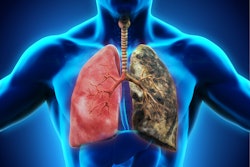Scientists have unveiled a prize-winning virtual reality (VR) tool designed to optimize radiation protection during interventional radiology procedures. It's now available for free download.
"Personnel in interventional procedures are exposed to the highest levels of radiation in the course of their professional activities. However, the potential effects and the benefits of radiation protection measures are often underestimated because they cannot be easily observed and are only noticed in the long term," noted Hugo de las Heras Gala, PhD, officer for quality assurance in x-ray radiology at the Federal Office for Radiation Protection (BfS), and colleagues.
 The room and all accessories have been designed to enable clinically useful training sessions. Courtesy of Silas Fuchs Northdocks GmbH.
The room and all accessories have been designed to enable clinically useful training sessions. Courtesy of Silas Fuchs Northdocks GmbH.
Training in VR offers the opportunity to learn and practice the correct behavior of medical personnel and the proper use of protective devices -- independent of location and time and without any hazards from radiation, they told ECR 2024 delegates in an e-poster that received a certificate of merit award. To ensure the training is convincing and instructive, it's vital to simulate radiation as precisely as possible and to calculate the reduction of radiation exposure, so the team's main goal was to simulate and visualize radiation and display the calculated reduction in exposure when protective devices are used in a VR setting.
"We designed a realistic environment to interact with a C-arm and with the protective measures of a typical interventional room, visualize the (simulated) radiation during image acquisitions and observe the effect on organ doses and the effective dose," the researchers explained, adding that the app permits the optional use of wearing a lead apron, thyroid collar, glasses and head cover as well as the use of different projections, lower body shields and mobile shields.
The tool also allows the adjustment of the distance to the isocenter and the separation from the detector to the patient, as well as the image rate and collimation diameter. Conebeam CT acquisitions can be performed too, and the automatic exposure control with gloves is another option.
Before this month's official launch of the app, the impact of the training was validated by 32 members of interventional staff in all career stages using a questionnaire before and after a 20-minute training session. The session included a 10-minute tutorial that was identical for all participants, the authors pointed out.
The results showed an average increase of 57% in the correct estimation of the protective factor of measures incorporated in the training. Only 11 out of 30 respondents answered correctly before the training. Also, nearly 91% of the participants agreed or strongly agreed to the assertion: "The representation of the radiation was helpful to my understanding."
The app visualizes ionizing, very high-energy radiation as it occurs under real conditions in a cardiac catheterization lab and elsewhere, they stated in an article posted on the BfS website on 8 April 2024 (www.bfs.de/vr-medicine). Scattered radiation and the shielding effect of patient protective equipment become visible, and the tool also calculates in real-time the effective dose that affects people present in the room.
The VR environment was developed by Northdocks GmbH together with the BfS, and the app was created as part of the departmental research program of the Federal Ministry for the Environment. Any user will need VR glasses, including a controller and a PC or laptop with the following minimum requirements: First-generation Intel Core i7 processor or equivalent; graphics card NVIDIA GeForce GTX 1070 or equivalent; 16 GB RAM of memory; Windows 10; and a WiFi or cable connection for the VR glasses.
The co-authors of the ECR exhibit were Dr. Katharina Stella Winter, Felix Höfer, and Silas Fuchs.



















